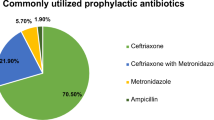Abstract
Purpose
To investigate the incidence of surgical site infections (SSIs) according to risk factors, etiological agents, antimicrobial resistance rates of pathogens, and antimicrobial prophylaxis (AMP) in a developing country.
Methods
Prospective surveillance of SSIs was carried out in general surgery (GS) units between May 2005 and April 2009.
Results
SSI was diagnosed in 415 (10.8 %) patients. Cefazolin was used as AMP in 780 (49 %) operations, whereas broad-spectrum antibiotics were used in the remaining operations. AMP was administered for >24 h in 69 and 64 % of the GS patients. The most significant risk factors for SSI after GS were total parenteral nutrition, transfusion, and a drainage catheter. The most common pathogen was Escherichia coli, but all the isolated pathogens were multiresistant.
Conclusion
AMP is effective for reducing the risk of SSI; however, the prolonged use of AMP and broad-spectrum antibiotics may be associated with the emergence of resistant bacterial strains.

Similar content being viewed by others
References
Weber WP, Zwahlen M, Reck S, Feder-Mengus C, Misteli H, Rosenthal R, et al. Economic burden of surgical site infections at a European University Hospital. Infect Control Hosp Epidemiol. 2008;29:623–9.
Allegranzi B, Bagheri Nejad S, Combescure C, Graafmans W, Atter H, Donaldson L, et al. Burden of endemic health-care-associated infection in developing countries: systematic review and meta-analysis. Lancet. 2011;377(9761):228–41.
Bratzler DW, Houck PM, for the Surgical Infection Prevention Guideline Writers Workgroup. Antimicrobial prophylaxis for surgery: an advisory statement from the National Surgical Infection Prevention Project. Clin Infect Dis. 2004;38:1706–15.
Mangram AJ, Horan TC, Pearson ML, Silver LC, Jarvis WR. Guideline for prevention of surgical site infection, 1999. Infect Control Hosp Epidemiol. 1999;20:250–78.
Talbot TR. Surgical site infections and antimicrobial prohylaxis. In: Mandell GL, Bennett JE, Dolin R, editors. Principles and practice of infectious diseases. United States: Churchill Livingstone Elsevier; 2010. p. 3891–904.
Horan TC, Andrus M, Dudeck MA. CDC/NHSN surveillance definition of health care-associated infection and criteria for specific types of infections in the acute care setting. Am J Infect Control. 2008;36:309–32.
Edwards JR, Peterson KD, Mu Y, Banerjee S, Allen-Bridson K, Morrell G, et al. National Healthcare Safety Network (NHSN) report: data summary for 2006 through 2008, issued December 2009. Am J Infect Control. 2009;37:783–805.
Brandt C, Sohr D, Behnke M, Daschner F, Rüden H, Gastmeier P. Reduction of surgical site infection rates associated with active surveillance. Infect Contr Hosp Epidemiol. 2006;27:1347–51.
Eriksen HM, Chugulu S, Kondo S, Lingaas E. Surgical-site infections at Kilimanjaro Christian Medical Center. J Hosp Infect. 2003;55:14–20.
Fehr J, Hatz C, Soka I, Kibatala P, Urassa H, Smith T, et al. Risk factors for surgical site infection in a Tanzanian Disrict Hospital: a challenge for the traditional national nosocomial infections surveillance system index. Infect Control Hosp Epidemiol. 2006;27:1401–4.
Raza MW, Kazi BM, Mustafa M, Gould FK. Developing countries have their own characteristic problems with infection control. J Hosp Infect. 2004;57:294–9.
Hambraeus A. Lowbury Lecture 2005: infection control from a global perspective. J Hosp Infect. 2006;64:217–23.
Alexander JW, Solomkin JS, Edwards MJ. Updated recommendations for control of surgical site infections. Ann Surg. 2011;253:1082–93.
Campbell DA, Henderson WG, Englesbe MJ, Hall BL, O’Reily M, Bratzler D, et al. Surgical site infection prevention: the importance of operative duration and blood transfusion-rates of the first American College of Surgeons-national surgical quality improvement program best practices initiative. J Am Coll Surg. 2008;207:810–20.
Talbot TR, D’Agata EMC, Brinsko V, Lee B, Speroff T, Schaffner W. Perioperative blood transfusion is predictive of poststernotomy surgical site infection: marker for morbidity or true immunosuppressant? Clin Infect Dis. 2004;38:1378–82.
Tesfahuengn Z, Asrat D, Woldeamanuel Y, Estifanos K. Bacteriology of surgical site and catheter related urinary tract infectionsamong patients admitted in Mekelle Hospital, Mekelle, Tigray, Ethiopia. Ethiop Med J. 2009;47:117–27.
Kobayashi M, Takesue Y, Kitagawa Y, Kusunoki M, Sumiyama Y. Antimicrobial prophylaxis and colon preparation for colorectal surgery: results of a questionnaire survey of 721 certified institutions in Japan. Surg Today. 2011;41:1363–9.
Prospero E, Barbadoro P, Marigliano A, Martini E, D’Errico MM. Perioperative antibiotic prophylaxis: improved compliance and impact on infection rates. Epidemiol Infect. 2011;139:1326–31.
McHugh SM, Hill ADK, Humphreys H. Intraoperative technique as a factor in the prevention of surgical site infection. J Hosp Infect. 2011;78:1–4.
Acknowledgments
We thank the Editing Office of Erciyes University for suggestions about English usage.
Conflict of interest
No competing financial interests exist.
Author information
Authors and Affiliations
Corresponding author
Rights and permissions
About this article
Cite this article
Alp, E., Elmali, F., Ersoy, S. et al. Incidence and risk factors of surgical site infection in general surgery in a developing country. Surg Today 44, 685–689 (2014). https://doi.org/10.1007/s00595-013-0705-3
Received:
Accepted:
Published:
Issue Date:
DOI: https://doi.org/10.1007/s00595-013-0705-3



